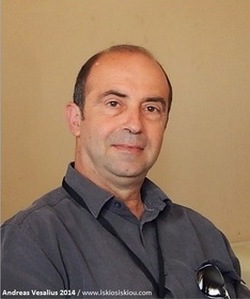
Pavlos Plessas
Pavlos Plessas was born and brought up on the island of Zakynthos (Zante) in Greece. He lives in London but maintains an internet blog that explores the history of his native island. He is a historian of the island and an internet blogger.
Knowing the island, its history and its people he never believed that Vesalius was shipwrecked, left to die helpless and buried near the beach of Laganas. When the local interest in Vesalius was rekindled by the visit of Pascale Pollier and Theo Dirix, he tried to separate the evidence from rumours and speculation to see if a rational explanation of the mystery could be found.
He was approached by Pascale Pollier and Theo Dirix and asked to assist in their search for Vesalius' grave. With the help of local people and old maps he found the approximate location of the Santa Maria church, by which Vesalius had been buried. The scientific work of Dr. Sylviane Dederix confirmed that this was indeed the spot where the church once stood.
Thanks to Pavlos Plessas for collaborating with "Medical Terminology Daily" and allowing us to re-publish his work on "Powerful indications that Vesalius died from scurvy", presented originally at the 2014 "Vesalius Continuum" meeting in Zakynthos, Greece.
UPDATE: Pavlos' article and theory was refutted by Theo Dirix and Dr. Rudi Coninx. both contributors to this blog. Their article is entitled "Did Andreas Vesalius really die from Scurvy?". Not to be undone, Pavlos published his own rebuttal to their theory in the article "An answer regarding the death of Andreas Vesalius".
Following are some links to Pavlos Plessas' blog articles:



